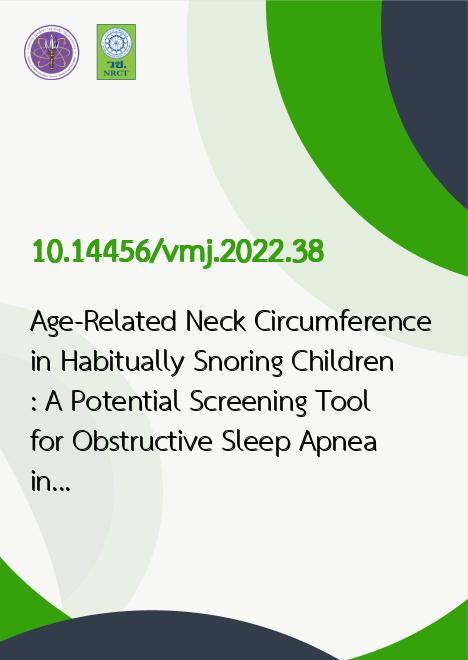
|
Age-Related Neck Circumference in Habitually Snoring Children: A Potential Screening Tool for Obstructive Sleep Apnea in Children |
|---|---|
| รหัสดีโอไอ | |
| Creator | 1. Tayatorn Sudsuansee 2. Wiriya Nilprapa 3. Worawan Rojanawong |
| Title | Age-Related Neck Circumference in Habitually Snoring Children: A Potential Screening Tool for Obstructive Sleep Apnea in Children |
| Publisher | Text and Journal Publication |
| Publication Year | 2565 |
| Journal Title | Vajira Medical Journal |
| Journal Vol. | 66 |
| Journal No. | 6 |
| Page no. | 369-380 |
| Keyword | neck circumference, habitual snoring, children, obstructive sleep apnea, screening |
| URL Website | https://tci-thaijo.org/index.php/VMED |
| Website title | Vajira Medical Journal (วชิรเวชสาร) |
| ISSN | 0125-1252 |
| Abstract | Objective: Neck circumference (NC) is becoming useful for various diseases in adults but not children. Due to a lack of normalized data. This study uses the normalized NC to compare with a patient's NC as a percentage (%NC) in habitually snoring children to distinguish obstructive sleep apnea (OSA) cases. The ratio of NC and adenoid thickness (NCAR) is hypothetically less in non-overweight OSA children. We proposed this ratio as a parameter to identify OSA in non-overweight children. Methods: Habitually snoring children who underwent overnight pulse oximetry (overnight SpO2)/ polysomnography (PSG) were eligible. Data gathering included an assessment of participants' body sizes and AT (from radiographs). Results: Overall, there were 73 children (65% boys, median age 10.6 y (IQR 7.4 12.7), 52.1% of whom tested positive by either test. In addition, 58.9% of children underwent overnight SpO2, and 20.9% tested positive. Among 30 children tested by PSG, confirmation of OSA diagnosis of varying severity was 96.7%. The positive and non-positive groups did not have statistically significant differences in %NC. In overweight children (n=40), there were no statistically significant differences of %NC between positive (n=27) and non positive (n=13) results [94.9 (88.3-104.1) vs. 93.4 (89.3-104.4), p-value 0.669]. But the non-overweight group, positive children (n=19) had a statistically smaller median NCAR compared to non-positive children (n=11); 14.3 (12.7-14.9) vs. 16.2 (14.7-20.3), p-value=0.006. The proposed cut-off NCAR value in predicting non-positive tests in non-overweight children is more than 13.95, with a 47.4% sensitivity and 100% specificity. The positive predictive value is 100%, and the negative predictive value is 68.6%. Conclusion: There was no statistically significant difference in %NC of the overall OSA vs. non-OSA children and the overweight OSA vs. non-OSA children. In the non-overweight group, NCAR was significantly smaller in positive children. |